After several years of revisions and reboots, Disney serves up Tangled, a thoroughly modern, seamlessly animated version of Rapunzel with memorable characters, inspired songs and surprisingly emotional moments.
A 17th century fairy tale about an unfortunate young girl who is imprisoned for most of her life in a tower doesn’t exactly scream to be adapted into a 3-D animated feature for modern audiences. However, thanks to several years of hard work, clever storytelling and dazzling CG animation by Disney, Rapunzel has inspired Tangled, a heart-warming spectacle that moves with spirited energy and wonderful roles for men, women, heroes, villains and a pair of unforgettable animal sidekicks as well.
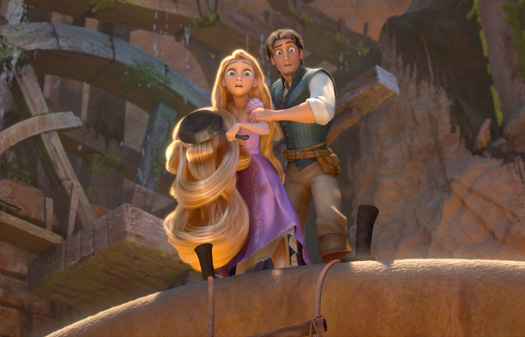
Directing Disney’s 50th animated feature was no easy task for Byron Howard and Nathan Greno, who came aboard about two years ago. “It was really important for us to offer a fresh, unique and energetic take on a fairy tale,” says Greno. “We are huge fans of Disney classics such as Pinocchio, Cinderella and Dumbo, and our goal was to deliver a contemporary take on the story without having a cynical tone,” adds Howard, who also directed the studio’s 2008 3-D CG movie Bolt.
According to Howard, Disney had been kicking around the idea of animating the fairy tale since the 1930s. Legendary character designer and story artist Joe Grant had made several attempts at developing it for the big screen. Animator Glen Keane (The Little Mermaid, Aladdin, Beauty and the Beast, Tarzan) had also been involved with the new incarnation of Rapunzel for many years. Keane got involved with the project about seven years ago, but he handed the reins to Greno and Howard after suffering from a heart attack.
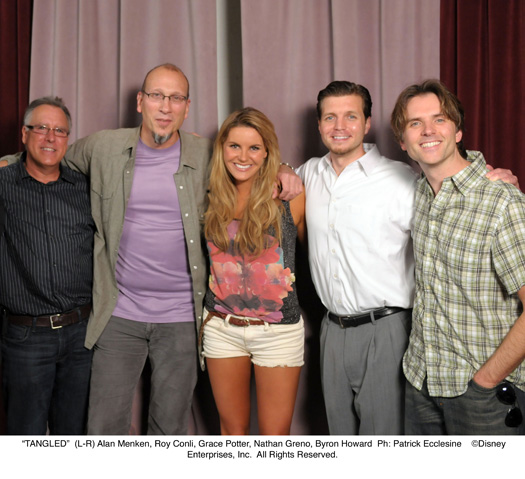
“When we were first developing the project, I presented it to Michael Eisner, who was the head of the studio at the time,” recalled Keane at the special Tangled panel at Comic-Con a few months ago. “He said, ‘Let’s do that, but I want you to do that in CG!’ I asked him, ‘Do you like the drawings? Well, you can’t do that in CG!’ He said, ‘Well, find a way!’ So we started to put the team together and we wanted to bring the feeling of hand-drawn to CG. Then, John Lasseter came on board and he told me, ‘I love this movie, but you have to decide whether you are going to do it in hand-drawn or CG.’ And I said, ‘Why weren’t you here three years ago? I would have given you a different answer three years ago.’ So we assembled this team of people who think that we can create a wonderful and unique film by accomplishing it in CG.”
Keane also noted that the initial designs and storyboards really define the style of the movie. “I learned from Frank Thomas and Ollie Johnston that what you want are golden poses—images you plant in people’s minds that really stick there.” He also praised the film’s co-directors. “They are both wonderful actors. Both of these guys have great strengths. Byron would have this sharp sense of comedic timing and Nathan would have some sincere emotional point that would bring tears to your eyes.”
Starting from Scratch
“Nathan and I wanted to approach the movie with a clean slate,” says Howard. “We wanted to reverse expectations so that our heroine isn’t a noble princess. She’s a very real girl, someone you can easily relate to. She is intelligent, pretty and talented, but we had to get her out of the tower by the end of the first act. She has to get out and see what she’s been missing all her life.
The directors also wanted to freshen up the traditional hero’s role in the movie. They added a special level of comedy and unexpected character flaws for Rapunzel’s “rescuer,” Flynn Rider. “Instead of a prince, we have a thief, who has a mysterious, darker past,” explains Howard. “The horse he rides on is a super-cop horse named Maximus, who is on the trail of the thief. We certainly wanted to keep things tangled!”
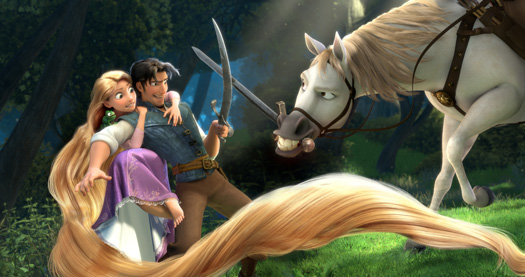
The animation team also looked back at many of the studio’s classics from the ‘40s and ‘50s to find various visual inspirations. “Those movies were filled with so much sincerity and heart, so we looked at them for those ingredients,” says Greno. “But we also had to keep in mind that our film was aimed at a modern audience, the pacing and the humor had to be of the now to able to compete with the other theatrical releases.”
Disney/Pixar’s chief creative officer John Lasseter also provided the helmers with an important piece of advice. “He told us that we needed to make it as real as possible so that audiences would take the leap of faith,” says Howard. “We researched European design and geography heavily. We had to make sure that every leaf on every tree is depicted correctly. We looked at regions of Europe—Hungary, France, Austria—to get the right look. The city where the King and Queen live is an idealized conglomeration of various places, such as the picturesque village of Eze, located in the Côte d’Azur region of France, and Prague in the Czech Republic. Overall, the look of the film was influenced both by American folk art style and eastern European sensibilities. It’s also interesting to note that the chalk drawings we see on the walls of Rapunzel’s castle were created by Glen Keane’s daughter, Claire.”
Hair-Raising Tasks
Obviously, one of the biggest challenges the animators had to face was depicting Rapunzel’s golden locks in CG, a task suitable only for those with unlimited stamina and courage! Not only did the heroine’s hair play a key role in the plot, it also touched a lot of other surfaces and interacted with everything in many of the scenes.
“We had to crack this nut,” admits Greno. “We were pushing hard for the best story we could tell, so we didn’t want to be limited by what we were able to do technologically. Luckily, we work with an amazing team of technical geniuses. We went to them with this laundry list of things we wanted to do with the hair—and they went a little pale. But they went to work and came back and showed us things that were amazing and blew us away. Then, we would then ask them, ‘Now, can you put it all underwater?’ and they’d go pale again, but they would do it, week after week, raising the bar and making it all come together, despite the high level of difficulty.”
According to animation supervisor Clay Kaytis, animating Rapunzel’s 70 feet of hair was a technical task like no other. “If the movement doesn’t require interaction, like when she’s running or sitting or doing normal stuff, a straight simulation is added,” he explains. “But if she needs to grab her hair and throw it, that’s when it gets complicated. There are several different technical solutions, but the most basic one is for the animator to control it by hand, by moving a long tube.”

It was up to the vfx team led by Steve Goldberg to find a way of bringing the heroine’s hair to CG life, using a new software called Dynamic Wires. For every shot, the technical team would animate 147 different tubes representing the structure of the hair, which would then be rendered into a final image with up to 140,000 individual strands of hair.
The Heart of the Matter
Howard says after seeing the final version of the movie, he was surprised by the depth of emotion it is able to stir in audiences. “I don’t want to give away any of the plot points, but I really admire the subtlety and seriousness of the acting. There is a scene between the King and the Queen that is heartbreakingly beautiful. Glen [Keane] and the animation crew truly exceeded our expectations.”
The directors don’t shy away from the fact that they were under a lot of pressure to deliver the film in a very short period. “I guess ideally, we would have liked to have six more months,” says Howard. “We had to make quick decisions, but we really worked the stories as hard as we could. We would go over them six or seven times on the board, but in the end, you end up with the best of the material.”
Greno chimes in, “People are working such long hours, and they have to be away from their families on weekends. We are proud of the fact that we were able to fix every thing that we wanted to—our schedule never hindered the quality of the movie.”
Songs in the Key of Life
Howard also brings up the important, yet subtle, role Oscar-winning composer Alan Menken’s music and Glenn Slater’s lyrics play in the movie. “Alan wanted to take a different approach with the music,” says the co-director. “He believed that Rapunzel’s music should be something that would sound like Joni Mitchell or Cat Stevens. It’s all about a girl sitting in a room, playing guitar, so that’s why the score is reminiscent of ‘70s folk music. The point was to think of it less as a musical, and more like a movie with music—similar to Disney’s Pinocchio, Jungle Book or Cinderella, which aren’t musicals. They all have great, emotional songs that move the plot along.”
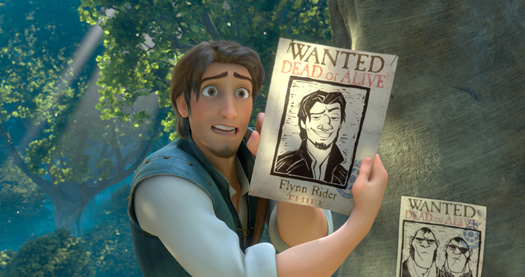
“There are no gratuitous songs in the movie,” adds Greno. “Audiences will see that there are few songs in the movie and they are all used in the service of the plot. We didn’t want to have songs just for the sake of having them.”
In addition to displaying stunningly fluid CG animation that rivals all the classic 2D fairy tales of the golden era, Tangled also uses stereoscopic technology to deliver some astounding you-are-there sequences. Howard and Greno worked closely with stereoscopic supervisor Robert Neuman to enhance the story using the possibilities of the medium. “Our priority was the story,” says Howard. “For instance, for the sequence that involves the floating lanterns, our emphasis was the emotions of the scene, not the lamp that is sticking out of the picture.”
“One of the reasons that Tangled lent itself so perfectly to 3-D filmmaking is that hair can be very effective in this medium,” says Neuman. “You feel the separation of the strands of hair and the volume. And there are some fun 3-D moments where Rapunzel’s hair is lowered down from the tower. The directors wanted to have a dynamic angle on the shot and have the hair either going straight away from the camera or straight towards it. This film represents that latest evolution for 3-D here at Disney,” he adds. “We’re using depth more artistically than ever before, and we’re not as concerned with the literal transcription of depth between camera and projector as we are the interpretation of it.”
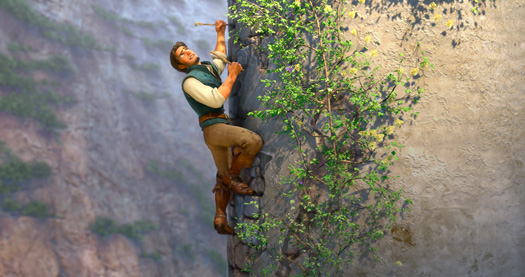
“We’ve all been to movies that make us ask ourselves, ‘Now why did that have to be in 3-D? Why did I have to pay the extra money to see that in 3-D?’” says Greno. “We were very aware of that. The floating lantern sequence is pretty amazing in 3-D. When it is used well, 3-D can really pull you in and make you forget about the technology.”
Like many of the helmers who have worked with Disney/Pixar topper John Lasseter, Howard and Greno are quick to point out his supportive approach and helpful suggestions. “Nathan and I worked on Bolt together and he was a great mentor for us,” notes Howard. “John wants both Disney and Pixar to be world-class animation studios, he leaves the subject matter to us.”
“We felt that he really trusted us and he just wants both Disney and Pixar to make movies that tell great stories,” adds Greno. “At Disney, we sometimes feel like we’re the New York Yankees. We have had some amazing season, and some that haven’t been great! We’ve always had great talent and amazing artists at the studio, but some weren’t allowed to get their vision on the screen. John and [Disney/Pixar president] Ed Catmull have given the studio a structure that lets talent shine.”
Howard, who previously paired up with Chris Williams on Bolt, says he and his Tangled co-director had the privilege of working together on many different aspects of the film. “I think it was a definite plus that we could be in every room together. It presents the crew with some strength of purpose, a super-brain of sorts!” he says.
Greno points out that after working in the story department at Disney for 15 years, he was ready to tackle a bigger project after he pitched his idea for the Bolt DVD short Super Rhino to Lasseter. “I knew story and editorial very well,” he explains. “The way I describe it is that I felt I had a certain set of superpowers, while there were other areas that I didn’t know as well. Byron has the animation background—he’s a genius. That’s why we work together really well: We have some areas where our superpowers overlap, but together, with our amazing team, we had enough superpowers to cover the giant scope that Tangled required.”
Although the dynamic duo are tightlipped about their next big adventure, they drop a few vague hints for their fans. “Well, we can say that if audiences enjoy Tangled, they’re definitely going to like our next project,” says Howard coyly. “We pitched it six months ago to John. We love these big movies with huge scope, that are also hilarious and have a lot of heart, too. It will be a different genre, though! It will be awesome!”
If it’s anything like the sublime holiday gift they’ve given movie-lovers this year, we kind of know it’s going to be pretty darn amazing.
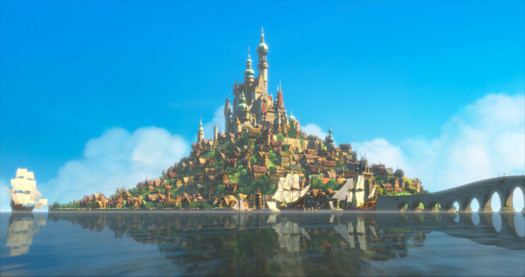
Disney’s Tangled opened in theaters on November 24. For more info, visit disney.go.com/tangled.


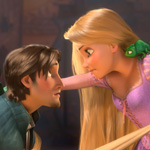

 Win a Funko X Lilo & Stitch Prize Pack!
Win a Funko X Lilo & Stitch Prize Pack! 
